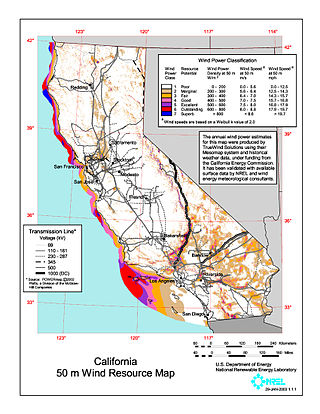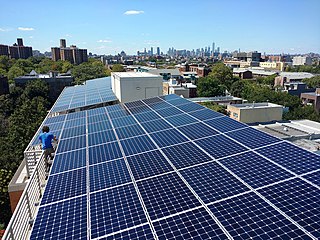
Solar Energy Generating Systems (SEGS) is a concentrated solar power plant in California, United States. With the combined capacity from three separate locations at 354 megawatt (MW), it was once the world's second largest solar thermal energy generating facility, until the commissioning of the even larger Ivanpah facility in 2014. It consisted of nine solar power plants in California's Mojave Desert, where insolation is among the best available in the United States.

Many countries and territories have installed significant solar power capacity into their electrical grids to supplement or provide an alternative to conventional energy sources. Solar power plants use one of two technologies:

The economy of the State of New York is reflected in its gross state product in 2022 of $2.053 trillion, ranking third in size behind the larger states of California and Texas. If New York State were an independent nation, it would rank as the 10th largest economy in the world. However, in 2019, the multi-state, New York City-centered metropolitan statistical area produced a gross metropolitan product (GMP) of $US2.0 trillion, ranking first nationally by a wide margin and would also rank as the 10th largest GDP in the world.

Solar power is a fast-growing industry in Australia. As of June 2023, Australia's over 3.52 million solar PV installations had a combined capacity of 32,095 MW photovoltaic (PV) solar power, of which at least 4,389 MW were installed in the preceding 12 months. In 2019, 59 solar PV projects with a combined capacity of 2,881 MW were either under construction, constructed or due to start construction having reached financial closure. Solar accounted for 12.4% of Australia's total electrical energy production in 2021.

Solar power is a fast developing industry in India. The country's solar installed capacity was 70.01 GWAC as of 30 June 2023. Solar power generation in India ranks fourth globally in 2021.

Wind power in California had initiative and early development during Governor Jerry Brown's first two terms in the late 1970s and early 1980s. The state's wind power capacity has grown by nearly 350% since 2001, when it was less than 1,700 MW. In 2016, wind energy supplied about 6.9% of California's total electricity needs, or enough to power more than 1.3 million households. Most of California's wind generation is found in the Tehachapi area of Kern County, California, with some large projects in Solano, Contra Costa and Riverside counties as well. California is among the states with the largest amount of installed wind power capacity. In recent years, California has lagged behind other states when it comes to the installation of wind power. It was ranked 4th overall for wind power electrical generation at the end of 2016 behind Texas, Iowa, and Oklahoma. As of 2019, California had 5,973 megawatts (MW) of wind power generating capacity installed.

Solar power includes solar farms as well as local distributed generation, mostly on rooftops and increasingly from community solar arrays. In 2022, utility-scale solar power generated 145.6 terawatt-hours (TWh), or 3.4% of electricity in the United States. Total solar generation that year, including estimated small-scale photovoltaic generation, was 204 TWh.

Concentrated solar power systems generate solar power by using mirrors or lenses to concentrate a large area of sunlight into a receiver. Electricity is generated when the concentrated light is converted to heat, which drives a heat engine connected to an electrical power generator or powers a thermochemical reaction.

Solar power has been growing rapidly in the U.S. state of California because of high insolation, community support, declining solar costs, and a renewable portfolio standard which requires that 60% of California's electricity come from renewable resources by 2030, with 100% by 2045. Much of this is expected to come from solar power via photovoltaic facilities or concentrated solar power facilities.

The energy sector in Hawaii has rapidly adopted solar power due to the high costs of electricity, and good solar resources, and has one of the highest per capita rates of solar power in the United States. Hawaii's imported energy costs, mostly for imported petroleum and coal, are three to four times higher than the mainland, so Hawaii has motivation to become one of the highest users of solar energy. Hawaii was the first state in the United States to reach grid parity for photovoltaics. Its tropical location provides abundant ambient energy.
Canadian Solar Inc. is a publicly traded company that manufactures solar PV modules and runs large scale solar projects.

Solar power in Virginia on rooftops is estimated to be capable of providing 32.4% of electricity used in Virginia using 28,500 MW of solar panels. Installing solar panels provides a 6.8% return on investment in Virginia, and a 5 kW array would return a profit of $16,041 over its 25 year life.

Solar power in the Netherlands has an installed capacity of around 19,143 megawatt (MW) of photovoltaics as of the end of 2022. Around 4,232 MW of new capacity was installed during 2022.

Energy in the U.S. state of Hawaii is produced from a mixture of fossil fuel and renewable resources. Producing energy is complicated by the state's isolated location and lack of fossil fuel resources. The state relies heavily on imports of petroleum. Hawaii has the highest share of petroleum use in the United States, with about 62% of electricity coming from oil in 2017. As of 2021 renewable energy made up 34.5%.

The electricity sector of Kosovo relies on coal-fired power plants and is considered one of the sectors with the greatest potential of development. The inherited issues after the war in Kosovo and the transition period have had an immense effect on the progress of this sector.
Solar Star is a 579-megawatt (MWAC) photovoltaic power station near Rosamond, California, United States, that is operated and maintained by SunPower Services. When completed in June 2015, it was the world's largest solar farm in terms of installed capacity, using 1.7 million solar panels, made by SunPower and spread over 13 square kilometers.
8minute Solar Energy is an American photovoltaic (PV) developer of utility-scale PV power plants and energy storage.













